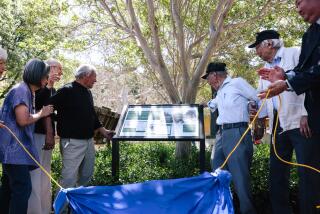Sydney Harbor Unlocks Its Convict Past : Australia: No longer ashamed, city touts its founding fathers--or criminals--and fuels a tourism boom.
- Share via
SYDNEY, Australia — A landmark in the middle of Sydney Harbor, where the rotting corpse of a convicted murderer once swung from the gallows, now attracts tourists and super-models as the city promotes its convict heritage.
Ft. Denison, built on a rocky outcrop to protect Sydney from attack and to confine its worst convicts, is undergoing dramatic renovations to satisfy a boom in tourists seeking out Sydney’s colorful past.
Not long ago, super-model Claudia Schiffer and a dozen other models held a party at the fort, once called “Pinchgut” after the emaciated bodies of convicts chained to its walls.
Today the fort’s attractions are more pleasurable.
Situated opposite the white fins of the Opera House, the fort has panoramic views of Sydney Harbor and has been called the best address in the city.
“It’s in fashion now for Australians to discover their convict history,” local historian and tour guide Maureen Fry said during a tour of Sydney Harbor.
“People will pore over history books in libraries to find out if they were related to a convict on the First Fleet,” she said.
Just a generation ago, the mere mention that one had convict blood was a major faux pas.
In Sydney’s “the Rocks”--the oldest part of the city, cradling the site where the first white settlers landed their convict-filled schooners in 1788 and built on a rusty sandstone promontory--tourism is up 25% in the last three years.
Bob Mitchell, executive director of the Sydney Cove Authority, which oversees the development of the Rocks, said a 23-year plan to restore the area is close to completion.
“You’ll be able to see the entire area refurbished, to be as close to original conditions as you can get,” he said.
The area was settled by the 759 convicts that Captain Arthur Phillip brought into the harbor in January, 1788, in 11 ships. Phillip, his crew and about 200 soldiers settled on a shoal across from the Rocks that now overlooks the Opera House.
The narrow lanes of the Rocks, which snaked around brothels and taverns filled with drunken sailors, are now far more innocent and swanky than they were in the 19th Century.
A fight by a band of Sydney residents in the early 1970s to ward off development and preserve the historic flavor of the area appears to be paying off. The Rocks is now the most popular tourist destination in Sydney.
The area, settled and built by convicted British felons, remains a model of early 19th-Century architecture. The brothels, however, have been replaced by small boutiques.
Tourism, one of Australia’s most lucrative industries, has been given a new push by politicians after Sydney’s successful bid in mid-September for the 2000 Olympics.
Andrew Mevissen, a spokesman for the New South Wales Tourism Commission, said the state expects 1.5 million tourists over the next 10 years, almost double current levels.
Between 1981 and 1991, tourism in Sydney jumped 130%.
But visitors aren’t the only ones swelling Sydney’s inner streets. The local population is also experiencing a sharp increase, largely due to increased immigration from Asia, the Pacific and many non-Anglo-Saxon European countries.
The sheer increase in Sydney’s population, which is expected to reach 4.5 million by 2011, up from the 1991 census figure of 3.7 million, prompted the state government to issue a plan in late October called “Sydney’s Future.”
The plan recommends a curb on growth in Sydney’s urban fringes, an emphasis on higher-density housing such as townhouses and villas, and improved transportation links.
More to Read
Sign up for The Wild
We’ll help you find the best places to hike, bike and run, as well as the perfect silent spots for meditation and yoga.
You may occasionally receive promotional content from the Los Angeles Times.






